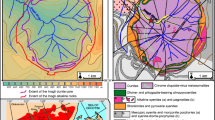Abstract.
The Shotgun deposit (30 tonnes gold; inferred resource using 0.5 ppm cutoff) consists of stockwork Au-As mineralization in a Late-Cretaceous (69.7±0.3 Ma, 40Ar/39Ar) granite porphyry stock located approximately 150 km north of Dillingham, SW Alaska. Preliminary metallurgical results indicate >90% gold is recoverable by cyanide leaching. With average estimated concentrations of 1.4 ppm Au, 6.1 ppm Ag, 0.5% As, 0.07% Cu, 40 ppm Mo, and 8 ppm Bi, Shotgun is a low-fO2 porphyry Au-As deposit that shares characteristics with both intrusion-related gold and porphyry copper deposits. The bulk of gold occurs in intense quartz stockwork and breccias. It is texturally identical to Cu-Mo porphyries, but has different mineralization and alteration assemblages. Shotgun contains arsenopyrite>>pyrite>pyrrhotite>chalcopyrite, lacks K alteration and, instead, contains vein and pervasive albite-quartz±sericite±carbonate. As temperature decreased, early high-temperature, low-fS2 mineralization (arsenopyrite-loellingite±pyrrhotite) evolved to later, lower-temperature, moderately high fS2 conditions (pyrite-bornite-chalcopyrite). In addition, ores at Shotgun contain primary native gold, native bismuth, Bi-Te sulfides, cubanite, maldonite, scheelite, and sphalerite, as well as supergene covellite, chalcocite, marcasite, and native copper. Arsenopyrite geothermometry yields deposition temperatures of 470 to 630 °C. Fluid inclusion microthermometry and laser Raman spectroscopy indicate that vapor-rich inclusions (H2O>>CO2>CH4) homogenize to vapor at ~360 °C, and saline aqueous inclusions contain 40 to >60 wt% NaCl equiv. (probably NaCl-KCl) and homogenize to liquid at 280 to >600 °C. Coexisting vapor- and liquid-rich fluid inclusions in quartz suggest 'boiling' occurred. Stable-isotope data include δ18O of 16.4 to 17.1‰ (quartz), δD of –124 to –105‰ (sericite), and δ34S of –5.5 to –5.0‰ (asp, cpy). At 380 °C, fluid compositions of δ18O of 10.4 to 11.1‰, and δD of –95 to –74‰ are compatible with a magmatic fluid source. Gold correlates fairly well (r>0.60) with Ag, Bi, Mo, and Te. When combined with the evidence for high-temperature fluids, the fragmental morphology of the intrusion, stockwork veining, and exsolution of vapor-rich and aqueous saline-rich fluid inclusions indicate a direct relationship between early mineralization and magmatism. The Shotgun deposit shares similarities with porphyry Cu-Mo-Au deposits (stockwork, breccia) and reduced, nonporphyry intrusion-related Au-As-Bi deposits (sulfide mineralogy, geochemistry, and oxidation state). They appear to be products of the same style of magmatic-hydrothermal systems and differ only in depth and thus volatile-release history. The Shotgun deposit is essentially an intrusion-related Au-As-Bi deposit emplaced at pressures and temperatures typical of a porphyry system.
Similar content being viewed by others
Author information
Authors and Affiliations
Additional information
Electronic Publication
Rights and permissions
About this article
Cite this article
Rombach, C.S., Newberry, R.J. Shotgun deposit: granite porphyry-hosted gold-arsenic mineralization in southwestern Alaska, USA. Min Dep 36, 607–621 (2001). https://doi.org/10.1007/s001260100192
Received:
Accepted:
Issue Date:
DOI: https://doi.org/10.1007/s001260100192




